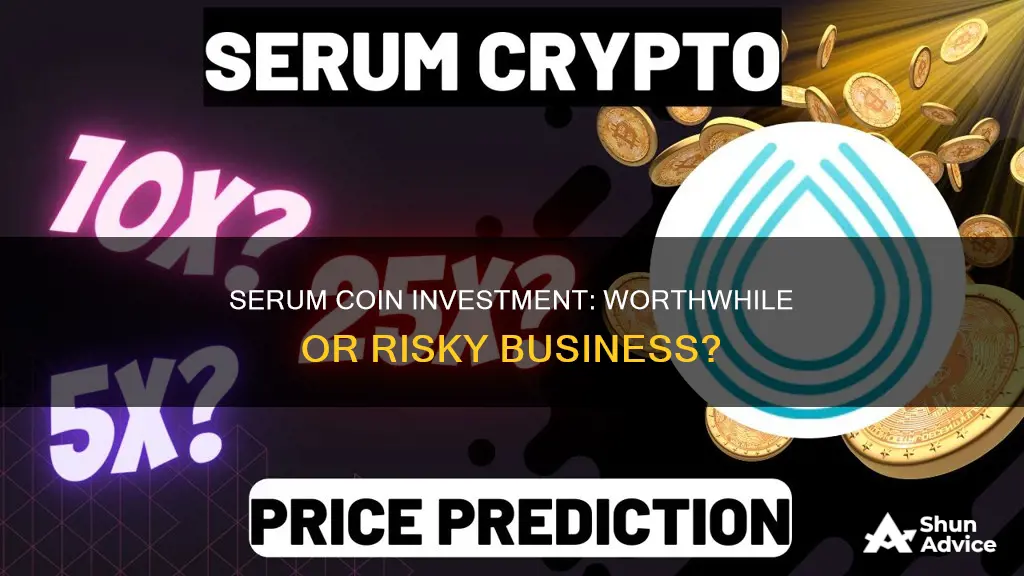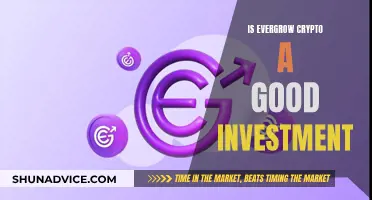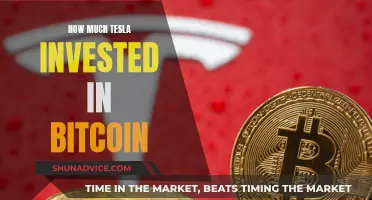
Serum (SRM) is a decentralised exchange (DEX) and ecosystem that aims to enhance decentralised finance (DeFi) by offering fast transactions and low costs. It is built on the Solana blockchain and is permissionless, meaning that users can transact without needing permission from a central authority figure. Serum's on-chain order book can be used by partner companies to transfer liquidity and power their trading features for retail and corporate clients.
Serum's native token, SRM, is still being traded, despite the collapse of the FTX exchange in November 2022, which left Serum without its biggest backers. The current price of SRM is $0.03104343, with a market cap of around $41 million.
So, is Serum coin a good investment? Well, that depends on various factors. Serum's price has been volatile, and while some analysts are bullish on the token, others are bearish. For example, CoinArbitrageBot predicts that SRM could rise to $1.40 in 2023, while Wallet Investor forecasts that the token's price could fall to $0.0144 by January 2024.
Ultimately, the performance of Serum will depend on factors such as the proposed fork, the performance of the market as a whole, and competition from other DEXs. As with any investment, it is essential to do your own research and remember that past performance is not indicative of future results.
What You'll Learn

Serum's performance in 2023
Serum (SRM) is a decentralised exchange (DEX) that offers fast transaction processing and low transaction costs for decentralised finance (DeFi). It is permissionless, built on the Solana blockchain, and is interoperable with the Ethereum blockchain.
Serum's price has been negatively impacted by the collapse of the FTX exchange, which left it without its biggest backers. Serum is dependent on FTX, and security is in jeopardy as FTX holds the upgrade authority. This has led to some protocols moving away from Serum.
However, there is still some hope for SRM following the announcement on 29 November 2022 of an ongoing plan to fork the crypto. According to CoinArbitrageBot, SRM could rise to $1.40 in 2023. Wallet Investor, on the other hand, predicts that the price of SRM will fall away over the next year, sinking to as low as $0.0144 by January 2024.
Hong Kong Bitcoin Investment: A Beginner's Guide
You may want to see also

How Serum compares to centralised exchanges
Serum (SRM) is a decentralised exchange (DEX) that offers fast transaction processing and low transaction costs for decentralised finance (DeFi). It is the first and only on-chain central limit order book and matching engine-based elevated DEX.
Serum's on-chain order book can be used by partner companies to transfer liquidity and power their trading features for retail and corporate clients. The token grants its owners access to protocol administration, staking rewards, trading fee exemptions, and transaction fees.
The benefits of Serum over centralised exchanges include:
- Speed: Serum runs on Solana, which has a block time of 400 milliseconds, making trading on Serum lightning fast and on par with centralised exchanges.
- Cost: Ethereum gas prices have become very expensive, with users paying up to USD 100 to process trades on DEXs. In contrast, Serum transactions cost as little as USD 0.00001 per trade.
- Decentralisation: Most DEXs offering derivatives rely on a centralised oracle (data provider) that provides a liquidation price. Serum will use only decentralised oracles to function.
- Cross-chain support: Most major DEXs only offer trading pairs between ERC-20 tokens on Ethereum. Serum has cross-chain support, meaning that assets like Bitcoin can be traded against other tokens from different base layer protocols.
- On-chain order book: Serum has an on-chain order book, allowing users to decide the price, size, and direction they want to trade. This gives traders more control.
Satoshi Nakamoto's Bitcoin: Why Invest?
You may want to see also

The future of decentralised finance
Decentralised finance (DeFi) is an emerging financial technology that uses blockchain technology to remove third parties and centralised institutions from financial transactions. It is still in its infancy but has been growing exponentially since 2020.
The future of DeFi is promising, with the potential to transform the legacy financial infrastructure as we know it. Here are some key aspects that indicate a positive outlook for the future of decentralised finance:
Permissionless and Open Access
One of the biggest draws of DeFi is its permissionless nature, allowing anyone to access financial services without the need for intermediaries such as banks. This is particularly beneficial for the estimated 1.7 billion people globally who are unbanked.
Composability
Composability in DeFi means that anyone can mix and match existing offerings to create new ones. This allows for easy innovation and the ability to build upon existing blocks, with everything governed by smart contracts.
Smart Contracts
Smart contracts are key to DeFi applications, as they allow for the automatic execution of actions when certain events occur. This enables the creation of new financial services and ensures the rules and conditions of execution are guaranteed by the network itself.
Increased Collaboration with Centralised Institutions
While DeFi challenges the use of centralised financial institutions, collaboration between decentralised and centralised finance could be transformative. Centralised financial institutions can contribute to developing regulations that ensure the advantages of DeFi are maintained while offering DeFi services to the unbanked and underbanked.
Regulatory Improvements
The lack of regulation in DeFi has been a concern, leading to issues such as a lack of consumer protection and the potential for illegal activity. However, as the industry matures, regulatory improvements are expected, which could address these issues and increase trust in DeFi.
Broader Adoption and Mainstream Acceptance
As DeFi continues to evolve and offer benefits such as increased efficiency, transparency, and accessibility, it is likely to gain broader adoption and move towards mainstream acceptance.
In conclusion, the future of decentralised finance looks promising, with the potential to revolutionise the way financial services are delivered and accessed. However, it is important to remember that the industry is still in its early stages and faces challenges such as security concerns and the need for improved regulation.
Bitcoin Capital Corp: A Wise Investment Decision?
You may want to see also

The role of the Serum Foundation
The Serum Foundation is a group of experts in cryptocurrencies, trading, and decentralised finance that built the Serum protocol. The Serum Foundation is responsible for creating Serum, a blockchain platform and permissionless decentralised exchange (DEX) based on Solana.
Serum intends to enhance the position of DEXes by providing all the advantages of a centralised exchange to the DeFi environment. While the majority of Serum’s features are seen as being immutable, SRM governance decisions can change some characteristics, such as potential costs. The SRM coins are purchased and burned using the total costs.
Serum is a decentralised exchange that offers fast transaction processing and low transaction costs for decentralised finance (DeFi). It is the first and only on-chain central limit order book and matching engine-based elevated DEX. Serum’s on-chain order book may be used by partner companies to transfer liquidity and power their trading features for retail and corporate clients.
The product aims to offer centralised cryptocurrency exchanges’ velocity and simplicity to the DeFi sector while maintaining visibility and trust. Based on the powerful Solana blockchain and its ability to communicate with the Ethereum network, it is completely permissionless.
Doge Coin Investment: A Beginner's Guide
You may want to see also

Serum's transaction fees
Serum is a decentralised exchange (DEX) and ecosystem that aims to bring speed and low transaction costs to decentralised finance (DeFi). Serum is built on the Solana blockchain, which is a web-scale blockchain that can reach 50,000 transactions per second and 400ms block times. This is achieved through a verifiable delay function, known as SHA 256 hash chain.
The SRM token is the native token of the Serum ecosystem. It is a utility and governance token that enables users to receive discounts on protocol fees and voting rights. Serum's whitepaper states that "Serum provides a fully on-chain orderbook, allowing applications such as trading interfaces to 'plug into' Serum's composable ecosystem". This means that Serum's partners can use its on-chain orderbook to share liquidity and power their trading features for institutional and retail users.
The transaction fees on Serum are touted to be "ridiculously low". During the testnet phase, none of the orders placed cost more than $0.0001, or 1/100th of a penny. Serum's matching engine is completely on-chain, which means it is not held back by the automated market-making (AMM) problems that most decentralised exchanges face. This gives Serum the potential to be the decentralised platform with the highest throughput.
Serum's low transaction fees are made possible by its integration with the Solana blockchain, which is known for its fast transaction speeds and low fees. Solana achieves this through its unique consensus algorithm called "Proof of History".
In addition to low transaction fees, Serum also offers its users the ability to choose the price, size, and direction of their trades. This flexibility is a unique feature of the Serum exchange mechanism.
BlackRock's Bitcoin ETF: A Guide to Investing
You may want to see also
Frequently asked questions
Serum is a decentralised exchange (DEX) and ecosystem that offers fast transaction processing and low transaction costs for decentralised finance (DeFi). It is built on the Solana blockchain and is permissionless, meaning that users can transact without the permission of a central authority figure.
As of August 2024, the price of 1 SRM token is $0.04112.
According to CoinArbitrageBot, SRM could rise to $1.40 in 2023. CoinPedia predicts that SRM could peak at $0.106 by the end of 2024. CoinCodex predicts that Serum will reach $0.106817 by July 19, 2024.
Serum offers faster transaction settlement times and lower fees compared to other networks. It also supports cross-chain trading, which is cheaper and more secure than trading through a third party. Additionally, Serum provides access to protocol administration, staking rewards, and trading fee exemptions.
Investing in cryptocurrencies like Serum (SRM) carries a high level of risk due to the volatility of the market. The value of Serum has been subject to significant fluctuations, and there is no guarantee that it will increase in the future. It is important to carefully consider your risk tolerance and conduct thorough research before investing.







